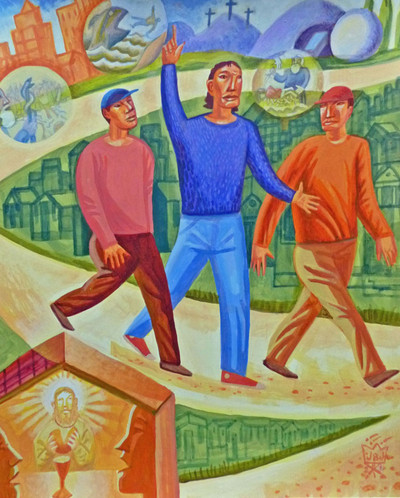
James Janknegt
Road to Emmaus
Acrylic on paper
From the numerous drawings of Rembrandt to the oft-reproduced painting of Swiss Artist Robert Zund, the appearance of the Risen Christ to two followers on the Road to Emmaus, as recorded in Luke 24:13-35, has long been a staple of Western religious art. Few artists have delved so deeply into the rich theological meaning of the story as Contemporary Texan Painter James Janknegt. As the narrative unfolds, the Resurrected Christ encounters two of his followers on their way to the town of Emmaus. Unrecognized by the pair, Jesus comes alongside them and hears them talking about his recent Crucifixion in Jerusalem. In the words of the Gospel writer: "Beginning at Moses and all the prophets, he expounded unto them in all the scriptures the things concerning himself (Luke 24:27, KJV)." Traditional depictions of three men gesticulating with their hands as they walk give no real sense of this momentous conversation we all wish we had overheard, but Janknegt has found a clever way in his acrylic on paper painting to suggest what it was all about. Floating like cartoon balloon captions above the wayfarers are three visual vignettes with "foreshadowings" of the Passion of Christ from the Hebrew Scriptures. Beneath a scene of Golgotha and the empty tomb, we see a circle with a depiction of Abraham offering his son, Isaac, in sacrifice (Genesis 22:1-14). This is followed by images of the Prophet Jonah swallowed by a whale (Jonah 1-2) and Moses lifting up a bronze serpent in the wilderness (Numbers 21:4-8). Christ used both of these Old Testament stories in the Gospels as emblems of his death and resurrection (Matthew 12:39-40 and John 3:14) Janknegt's work is strongly influenced by the folk art of Mexico and the American Southwest, and he refreshes this oft-depicted scene by presenting the wayfarers as three campesinos who might have just stepped out of a wall painting by one of the great Mexican muralists. At the end of this journey through a modern cityscape, a conventional image of the bearded Jesus reappears in what might be a gilded roadside shrine, commemorating the moment in the evening meal when the disciples finally realize in "the breaking of the bread" that the stranger in their midst is the Risen Christ--a look forward to the liturgy of the Eucharist. That's a lot of sacred truth packed into one painting! (John Kohan)
